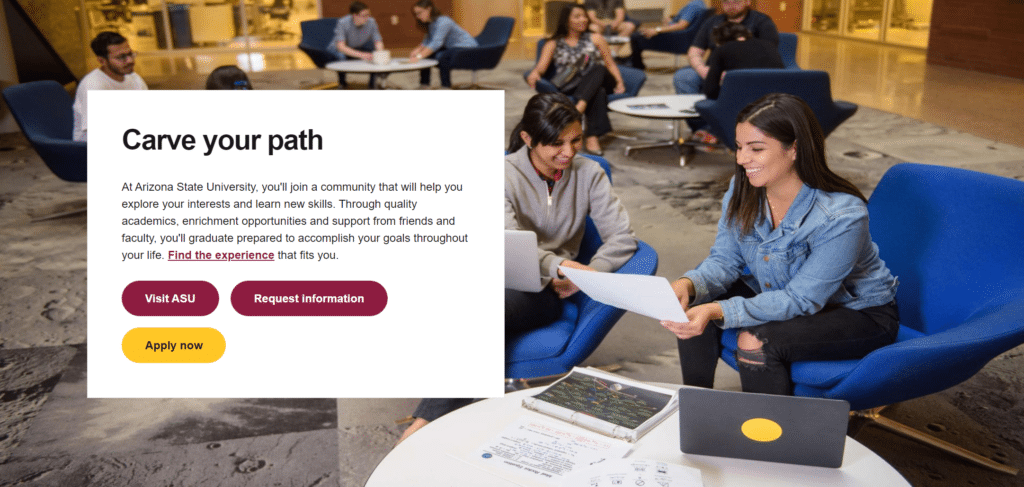How to Market a College with a Small Budget
Learn how to market a college with a small budget by leveraging generative AI, social media, and strategic thinking.
Featured
There are hundreds of tutorials on how to shoot campus photography, but what about the larger topics of asset management, quality control, or artistic selection?
Many marketers struggle with keeping track of their assets on campus with photography and videography.
This becomes even more of a challenge when you layer on how to handle student permissions to use their image for marketing purposes.
Depending on the size of your campus, you might have a few hundred shots, a few thousand, or even tens of thousands of shots!
But with the proper techniques, you can implement a campus photography program that can enhance the experience of your university—and save your sanity along the way!

Cindi is the Director of Strategic Marketing and Communication at Arizona State University.
In this capacity, Cindi manages teams of designers, photographers, videographers, and writers to create content and tell stories.
Her team is responsible for the multi-channel communications to prospective students and bases their work on data-based decisions and design thinking.
They have some really good, simple techniques they’re using to be able to keep track of everything.
These are techniques everybody can benefit from, no matter the size of your institution.
And you don’t have to have thousands of dollars’ worth of software to do it!
Improving your campus photography program can be done with simple tools like Google Drive.
Here are some of the actionable insights Cindi shared with us in our interview with her.
One of the drums I’m constantly beating is that I need to see people!
So many schools show me the photos on their website.
There’s the library… but it’s empty.
There’s the quad… but it’s empty.
This happens a lot with smaller schools who are out there during the summer taking the photos because it’s the chance they get to breathe.
Cindi shared this is because we can’t relate when there are no faces.
Our brains are hardwired for faces.
Across the whole world, we all share a first language, and that [language is] faces.
From the moment we’re born, we focus on faces for identity information of our caretakers but also for social cues.
It’s quite lovely we all share that first language of faces!
It’s so important to our brains that we have a very specific part of our brain called the fusiform gyrus that is dedicated to rest recognizing and processing faces.
Neurosciences have found over the years that we also have something called mirror neurons [which means our] brains are wired to experience emotions identical to the ones we’re observing and others.
So when we see somebody smile, that triggers joy in our own brains!
Just knowing the neuroscience behind faces, [shows us why] capturing joy is so important.
That is our first language.

Source: asu.edu
Most of the time when we make a purchase, we do so for emotional reasons.
Even for larger purchases, like a home, we are buying something for the way it will make us feel or how it fits into the story that we’re telling ourselves about our lives.
One of the biggest purchases someone might make in their entire life is a higher education.
Emotion is just as much a part of this purchase decision as buying a home, car, or a new iPhone.
Recognizing faces in campus photography can really start to transmit that emotion and help people feel that they’re already a part of your school.
So we’ve got to show faces.
But before you get ahead of yourself, let’s talk about one of Gen Z’s primary values: authenticity.
Generation Z students can spot a fake a mile away.
Our testing validates that [Gen Z doesn’t like inauthenticity].
We tested some graduation images just a couple of years ago. We had this really great studio shot, and it was totally posed. They were throwing balloons—they looked joyful, right?
But then we tested that against the actual event photo where people are authentically celebrating together and hugging each other, and you haven’t told the models what to do, you’re just capturing what’s real.
And the posed photo just tanked! Did not do well.
So testing is also very important. You know, we can’t trust our own opinions. We need to ask and listen.
Back in the day, a quality stock photo would cost you around $2,500 or $3,000.
That meant colleges and universities were slower to use it to fill out their marketing campaigns.
But once stock photography came down to a more accessible price, I’ve seen the same student model featured in about 37 different ads for schools.
This simply doesn’t come across as authentic campus photography to prospective students.
I was working with one of the Arizona State University lawyers from the general counsel office, and we had this healthy debate.
In typical lawyer fashion, she was like, “Cindy, you should never ever use a photo of a real student! Always buy stock photos.”
And I was like, “Wait! That is not the way we roll.” We have to tell real stories.
From a lawyer perspective, she wanted to keep the university safe. But from a storytelling perspective, I want to tell a real story.
So we did find compromises. We have a very rigorous process on how we collect the model releases, how we talk to students, and how we recruit students.
Campus photography or videography can be an amazing way to build relationships between your marketing and recruitment team and current students.
When you involve students in your marketing efforts through something like campus photography, you’re really asking them to co-create the campaign with you. The idea of co-creating can be a powerful motivator for students.
If you look at some of the stats—especially Generation Alpha and a lot of Generation Z— when they’re asked, “What do you want to be when you grow up?” the number one answer is a “YouTube creator,” or a “Social Media creator.”
When you ask them to participate in your campus photography program as a model, or even as a student photographer, you’re playing into that idea that they all want to be creators.
Along with that powerful idea comes great responsibility.
Beyond that, you’ve got to have a process internally to make sure that at a moment’s notice you can pull up the model release, or the signed consent document, if you need it.
You might think you need some high-powered, expense software to manage all of these consent documents, but Cindi showed us a simple, inexpensive way that is working for them at ASU.
When we go out on campus, we talk to [the students we’re going to photograph.]. It’s important to tell them what the photo is going to be used for.
“We’re the recruitment team. We do recruitment and marketing. This might be on websites or in brochures, [or billboards and buses].”
And then they sign the release.
Then, we take a picture of them holding the release. We file them physically and digitally.
We rename the photo by their name so that we can easily find it later.
It is a discipline. But it makes your life so much easier if in the future you need to find the release, or if you need to pull a photo.
This is a great idea for colleges and universities of any size.
Whether it’s your own personal server, or whether it’s a Google Drive or Dropbox account, you should be able to have model releases in there filed by their name.
Taking the photo of them holding their own signed consent form is also a brilliant move!
It promotes good communication, encourages meaningful collaborations, and protects your institution at the same time.
Like all of our blog post reviews of The Higher Ed Marketer podcasts, there’s so much more to learn in the podcasts themselves.
Listen to our interview with Cindi Farmer to get even more insights into:
Then you’ve got to know how to write for the web. That’s why we want to send you our popular ebook: Writing for the Web: 7 Secrets to Content Marketing Success for Education Marketers!
With this helpful resource, you’ll learn how to:
In short, you’ll be able to write the copy that makes your digital marketing strategy work for you. Download your copy today!
Featured image via asu.edu
Subscribe to The Higher Ed Marketer podcast today!